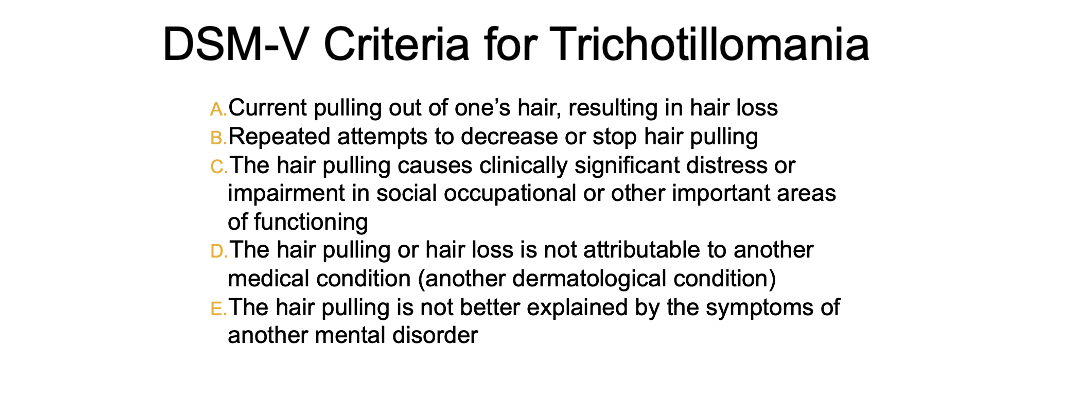Trichotillomania Associated with Lisdexamfetamine
Lisdexamfetamine ((Vyvanse®, Elvanse® etc) Associated Trichotillomania
Trichotillomania (TTM) is a mental health condition whereby an individual repeatedly pulls out his or her hair in a manner that leads to functional impairment or distress of some kind. It has been estimated that trichotillomania has a prevalence of somewhere between 0.6–3.6 % of adults and may also occur in children. It’s clear that a fairly high proportion of humans pull their hair at times but don’t actually meet the formal definition of TTM. The vast majority of people with trichotillomania have one or more mental health comorbidities such as anxiety/depressive disorders, OCD, PTSD, and ADHD.
A Closer Look at Stimulant Medications and Trichotillomania
Stimulant medications are FDA approved and widely prescribed in the United States for the treatment of attention deficit hyperactivity disorder (ADHD). The most common prescription stimulants are methylphenidate (Ritalin®, Concerta®), lisdexamfetamine (Vyvanse®, Elvanse®), and amphetamine/dextroamphetamine combinations (Adderall®). The use of stimulants has increased considerably in the last decade. This is especially true in the adolescent population, which has experienced a marked increase in the diagnosis of ADHD.
How do stimulants work?
Prescription stimulants work to raise the levels of dopamine and norepinephrine by a mechanism that involves blocking reuptake transporters in the central nervous system (CNS). Levels of dopamine and norepinephrine thereby increase in nerve terminals. Amphetamines and lisdexamfetamine also increase monoamine (ie dopamine, norepinephrine, serotonin) release from vesicles into the intracellular fluid of neurons. Compulsive behaviours are known by researchers to be associated with dopaminergic mesolimbic stimulation with dopaminergic treatment. In various animal models, the dopamine system has been shown to have a key role in stereotypic and grooming behaviors. Hair pulling and other stereotypic behaviours, have been shown to increase with dopaminergic agents and decrease with dopamine blockers.
Common Side effects of Stimulants
Given how widely stimulants are used, it’s important for practitioners to be aware of possible side effects. Side effects include decreased appetite, anxiety, diarrhea, dry mouth, insomnia, and rapid heart rate (tachycardia). More serious adverse effects include cardiovascular events, hypertension, peripheral vascular issues, serotonin syndrome, and psychiatric reactions (like mania or psychosis) can also occur.
Trichotillomania May be A Side Effect of Stimulants
A recent study identified 8 cases of trichotillomania induced by prescription stimulant use. 7 patients were pediatric and one was an adult. Every patient received prescription stimulants for the treatment of ADHD. Hair-pulling began anywhere from several days to several months after starting medications or increasing the dosage. Amphetamine, lisdexamfetamine, and methylphenidate were all found to precipitate the disorder. Symptoms resolved or diminished significantly after discontinuation of stimulant medication in almost all cases. Reemergence of hair pulling occurred in one patient who was rechallenged with methylphenidate.
We’ve reviewed that in the past. If interested, click on the link or the image below.
A New Study Links Trichotillomania to the ADHD Medication Lisdexamfetamine
A new report published in the March/April issue of the Journal of Clinical Psychopharmacology presents another case of trichotillomania following use of ADHD medications. The patient was a 9-year-old white boy with the diagnoses of ADHD, combined type, and generalized anxiety disorder. He was started on lisdexamfetamine 30 mg/day. Two months later, he was admitted to an inpatient psychiatry unit for severe anxiety with associated significant functional impairment and severe hair loss. The patient started engaging in hair pulling after he started taking lisdexamfetamine. He reported having urges for pulling hair and described some temporary relief in his anxiety immediately after pulling his hair.
When the boy’s dose of lisdexamfetamine was further increased to 50 mg/d to address residual ADHD symptoms his compulsive hair pulling kept on worsening. The dose of lisdexamfetamine was then tapered down to 30 mg/d due to complaints about worsening anxiety.
The authors point out that examination of the scalp showed nearly complete hair loss. The only hair that remained was a small patch of hair on the scalp and some near the neck. This was felt to be consistent with a diagnosis of “tonsure trichotillomania.” In addition, he was also pulling out his eyebrows.
During the course of hospital stay, lisdexamfetamine was discontinued and he was started on other medications to address the anxiety. This led to a reduction in hair pulling. During the rest of the stay on inpatient psychiatry, there was some hair growth that was noted on the scalp.
Comments
This report reminds us that hair pulling is a rare side effects of ADHD medications. There are an increasing number of these reports and physicians and practitioners of all backgrounds need to be aware of this rare link. Trichotillomania in children always requires a full scalp evaluation to ensure that other diagnoses are not also present. For example, alopecia areata co-exists with trichotillomania in some cases.
This case does not prove that the medication caused the trichotillomania but it suggests a link. The Naranjo score here is 5 which indicates a probably association.
RERERENCE
Jolly T et al. Lisdexamfetamine-Associated Tonsure Trichotillomania. J Clin Psychopharmacol. 2022 Mar-Apr 01;42(2):224-225.
This article was written by Dr. Jeff Donovan, a Canadian and US board certified dermatologist specializing exclusively in hair loss.


